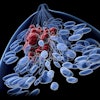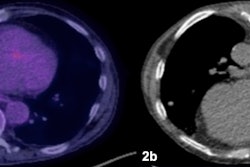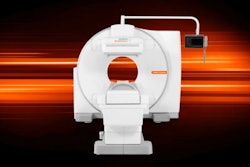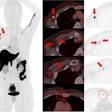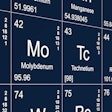Primary tumor F-18 FDG radiotracer uptake on PET/CT scans is an independent prognostic factor for survival in patients with non-small cell lung cancer (NSCLC), researchers in Seoul, South Korea, have reported.
The finding is from an analysis of imaging of 2,972 patients and suggests that the measurement should be added to initial staging systems, noted lead author Wonseok Whi, PhD, of Sungkyunkwan University, and colleagues.
“Primary tumor FDG uptake was an independent prognostic factor for survival in NSCLC. Its integration into staging improved risk stratification,” the group wrote. The study was published June 19 in European Radiology.
F-18 FDG-PET/CT is an essential tool in the initial staging and prognostication of NSCLC. In addition to detecting metastatic lesions, the technique provides metabolic parameters such as the maximum standardized uptake value (SUVmax), which reflects tumor glucose metabolism, the researchers explained. Studies have demonstrated that higher SUVmax values are associated with poorer prognoses.
However, the 9th edition of the American Joint Committee on Cancer (AJCC)/Union for International Cancer Control (UICC) staging system, published in 2024, does not include SUVmax as a formal staging or prognostic parameter, the group noted.
Hence, the researchers explored whether incorporating SUVmax into the ninth edition AJCC/UICC staging system could further enhance prognostic accuracy.
The group retrospectively enrolled 2,972 patients who underwent F-18 FDG-PET/CT examination for initial staging of NSCLC and subsequent definitive therapies between January 2007 and December 2016. All images were interpreted by two or more experienced nuclear medicine physicians, and at least one had more than 10 years of experience in reading F-18 FDG PET/CT results. Primary tumor SUVmax was measured using volume viewer software.
According to the results, primary tumor SUVmax was an independent prognostic factor in the univariate and multivariate analyses for overall and disease-free survival, alongside disease stages. Integrating SUVmax into the staging system improved prognostic stratification, especially in intermediate stages: stage IIA versus IIB, hazard ratio [HR] = 1.06, p = 0.72 for the conventional staging system; HR = 1.27, p = 0.04 for the staging system with SUVmax.
“Incorporating SUVmax into the staging system improved prognostic discrimination compared with the conventional staging methods alone,” the group wrote.
SUVmax of the primary tumors is the most widely used semiquantitative parameter from F-18 FDG-PET/CT scans, as it reflects tumor glucose metabolism and serves as an indicator of tumor aggressiveness, the group noted.
This study suggests that incorporating SUVmax from F-18 FDG-PET/CT scans could refine the current staging system, particularly for patients with stage II or lower NSCLC, and ultimately improve patient management, they wrote.
“Further prospective studies are needed to validate the clinical impact of incorporating SUVmax into treatment algorithms, but our findings suggest that it is a promising avenue for enhancing the precision of NSCLC management,” the researchers concluded.
The full study is available here.


